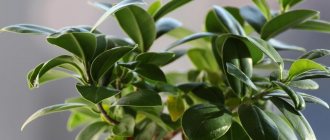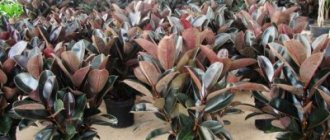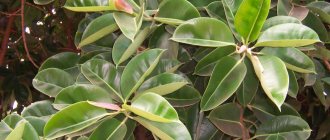All ficus belong to the mulberry family, the main part and all species grow in Asia, and this plant can be found in the tropics and subtropics of both hemispheres. Therefore, the homeland of the ficus requires special care.
The abundance of this genus is represented by more than 800 species. Among the variety of these species, you can choose deciduous and evergreen ficuses, depending on their growth form, they can be shrubs, creeping or in the form of a tree. A variety of varieties of this or that ficus are represented by different leaf shapes and their colors.
Ficuses are the most common indoor plant among gardeners. At home they can grow for a long time.
When working with these plants, be careful, as the milky sap that secretes the juice is poisonous.
Compliance with all growing conditions will allow you to achieve optimal development and growth of your indoor plant. Ficus in the house is always a beautiful plant and comfort.
When choosing a plant, you must understand the characteristics of its cultivation, the variety of species, which provides ideal conditions for design.
Here are several types of popular ficuses: F. bengal, F. benjamina, F. oakleaf, F. cape, F. rubber (elastica), F. large-leaved, F. lyre-shaped, F. creeping, F. ivy-shaped. Regardless of the type, in general the growing conditions are the same for all types of ficus. Types of ficus differ from the shape of the leaf, its color; you can read more about the types of ficus here .
Signs and ficus
There is a belief that ficus and pregnancy are interconnected. If you buy a ficus for your home and place it in the bedroom, it will help you get pregnant soon. Ficus and pregnancy signs say that you need to grow a ficus from a small plant yourself, as if you were raising a baby. Some even wonder what to call ficus. There are signs and superstitions about ficus, but one thing is wonderful - this plant looks great in any home. In an apartment, ficus blooms very rarely, but it brings a piece of nature into the house. Any plant loves attention and good conditions; of course, it can be grown at home.
Procedure
- Make several longitudinal shallow cuts on the bare branch. Roots will soon appear at the incision sites.
- Treat the cut area with a root stimulator.
- Wrap the prepared area with moistened sphagnum moss and polyethylene on top of it.
- Secure the top and bottom of the polyethylene with tape or tape.
- Now all that remains is to wait for the roots to appear, cut off the branch and replant it in a new container.
This method is an ideal way to renew an old ficus that has lost its decorative properties. To do this, root formation is stimulated on the central trunk, and then it is transplanted into a new tub. The main thing is not to rush and wait until the ficus grows a powerful measles system.
How to care for ficus
Different types of ficus require different growing conditions. Small ones are best placed on the windowsill; tall and large ones should be placed on the floor, but away from the heating system. Especially in winter. Ficus plants are ready to tolerate any lighting and temperature conditions. But ficus care must be constant. Let's figure out how to care for ficus at home.
Under natural conditions, you can observe the flowering of ficus, but caring for ficus at home is unlikely to allow you to see how ficus blooms.
- The soil. The soil is suitable for ficus - universal for indoor plants, there are also mixtures specifically designed for growing ficus. The ideal soil mixture for planting ficuses: turf, leaf, with the addition of peat and sand (1:1:1). Peat, turf and leaf soil are taken in equal parts, sand must be added.
For greater aeration, add perlite or vermiculite. The bottom of the pot must be covered with expanded clay. This will allow moisture to pass through calmly and not stagnate in the pot. If the ficus is large, it will need more soil and a larger pot.
- Landing. To plant ficuses, choose a pot that suits the plant itself. I don’t recommend taking a very spacious pot, since there is a lot of space and the soil in it has time to stagnate faster than the plant can fill it with roots.
When planting, the pot should be slightly larger in diameter than the plant itself. In other words, the plant in the planting pot should be slightly smaller than the new pot. If planted well, indoor ficus will delight you with its beauty for a long time.
- Transfer. All ficus transplants are carried out in spring. Replanting is done only if the earthen lump of the plant has filled the entire pot. Ficus trees do not tolerate transplantation well. In order to replant a ficus, you need to carefully remove it from the pot, trying not to damage the earthen lump of the plant. And we also plant it in a new pot, which should be slightly larger than the previous one in both height and diameter.
I recommend replanting young ficuses once every two years, but adults once every few years. But it’s better as the pot is filled with roots. The ideal option is not to touch the plant at all, but simply replace the top layer of soil.
Soil for planting young ficus
Soil for decorative green ficus can be purchased at the store. “Universal” is suitable, which includes compost, peat, and leaf humus, but young plants can be replanted into it when they have built up a root system and begin to grow. This is a signal that the seedlings can feed themselves using their roots.
If you take soil from the garden, you must first spill it with a fungicide solution to destroy pathogenic bacteria and fungal spores. For looseness, add sand, vermiculite, perlite or brick chips.
It is important that a drainage layer is laid at the bottom to drain excess water. There should be an air gap between the bottom of the pot and the tray - this will protect the roots from rotting.
Where to put
— Lighting . All ficuses with green foliage should be in a well-lit and bright place. If you don’t have enough light, the ficus shoots will bend, which will lead to a loss of decorativeness. Additional lighting can be used. Or you may need to rotate your ficus pots regularly to provide adequate light to the entire plant.
- Temperature . Try to create the optimal temperature. We do not allow temperature fluctuations. In summer, ficuses love warmth; 22-24 is the most optimal temperature, which should not fall below 18 degrees. But winter is a time of peace. The temperature should be a little cooler - 12-13 degrees.
I do not recommend placing ficus trees on a cold windowsill or floor. This will cause a temperature difference in the soil in the pot. Use trays of warm water - this will warm the pot from below. You can fill the tray with expanded clay and place the pot on it, add warm water.
- Humidity . Ficus plants love high humidity, which must be maintained year-round. Especially in winter, when the heating is turned on and the air in the room becomes much drier. Constant spraying, wiping the leaves with a damp cloth.
Spraying and treating leaves will allow you to remove accumulated dust and also help prevent pests. During winter, expanded clay can also be used in pallets. We fill the trays with water and this will provide additional humidity.
Care after landing
After rooting a ficus in a pot with soil, it needs light, but it is impossible to leave a still weak plant in direct sunlight. A south-facing window sill is suitable for growth, but there the flower needs shading in the form of blinds or curtains.
Pruning and rooting of new plants is usually carried out in the spring - this is the best time, as daylight hours gradually increase. If you propagate ficus in the fall, after transplanting it into the ground, it will need a phytolamp for additional lighting in winter.
Watering
Beginners in floriculture usually have difficulty figuring out how often to water their ficus. This depends on several factors:
- Soil quality - if the composition contains clay, reduce the frequency of watering.
- Size of tub or pot.
- Intensity of lighting and solar heat. In hot weather, plants absorb more moisture.
In winter, when ficuses are at rest, they need to be watered less often. Here the main guideline is the room temperature: if the apartment is hot, watering is carried out once a month. If the plant is in a cool place, then water it as the soil dries. They also pay attention to the condition of the foliage - if it is drooping, the ficus needs to be watered.
Carefully! Excess water in the cold season in a cool room leads to rotting of the roots. The ficus will most likely shed its leaves and the branches will become bare
How to water
- Watering. During growth, water the ficus frequently. The earthen ball should always be slightly moist. Water for irrigation should be well settled. In winter, when heating, water frequently. Do not overwater ficus plants - they react poorly to waterlogged soil.
- Feeding. All ficus plants are fast-growing plants - they constantly need nutrients. Use mineral fertilizers in liquid form. Add fertilizer to the water for irrigation. In summer we feed twice a month, and in winter only once a month, and it is better to do this on a cloudy day or in the evening.
Reproduction
Benjamin reproduces by young shoots, which can be kept in water until roots appear, or you can immediately plant the shoot in the ground under a glass jar. The jar is removed after rooting.
- Ficus benjamina can be given different shapes, whichever you prefer:
- trim the side shoots, the plant will tend upward and take on the appearance of a tree
- trim the top of the plant, Benjamin will grow into a lush bush
Useful video on propagating ficus "Benjamina Mix":
Remember that all manipulations with Ficus Benjamina Mix, be it replanting or cutting shoots to give it shape, should be carried out in the spring and summer.
Crown formation
Many types of ficus require crown formation. Many new shoots and giving the desired shape to your ficus depend on this. It is better to do this procedure in the spring. Regardless of the age of the plant, cut off the tops.
This is done on both young and adult ficus trees. Thanks to this formative pruning, new shoots are formed and a lush crown of the plant is obtained. It is especially effective with ficus trees, which are grown as trees.
You can plant several varieties of one ficus in one pot, and as they grow, the shoots intertwine and form a huge crown, consisting of different varieties of ficus, such options are convenient for Benjamin ficuses, with different leaf colors.
Description
About a thousand different species of ficus have been described that grow in Australia, Asia, America and Africa: each of them has its own habitat.
The plant relieves accumulated fatigue, aggression and irritation, adds determination and confidence.
This tree has long been revered in the Hindu religion. Buddhists built temples near the sacred ficus. According to legend, it was under the ficus tree that Prince Gautama reincarnated as Buddha, and here he communicated with his followers. Pilgrims from all over the world tie colorful ribbons on ficus branches. Christians also highly value this tree. In the Holy Bible, the ficus leaf became the first item of clothing of Adam and Eve.
How to propagate
Ficus can be propagated in various ways: stem and apical cuttings, air layering, buds and leaves. However, the method of propagation depends on the type of ficus. When reproducing, we choose the desired method.
Propagation by cuttings.
We cut the cuttings at the beginning of spring; it should have two or three leaves. In other words, it should be a top cutting with a growing point. You need to dry the cut of the cutting and wait for the milky juice to come out of the cutting.
To root cuttings we use sand or expanded clay. The end of the cutting can be treated with root or another stimulant. Cover the container with cuttings with a bag or plastic bottle - you need to create greenhouse conditions.
Maintain constant humidity and place in a bright and warm place. Try to avoid direct sunlight. You can also use water to root cuttings; they root well in water, the main thing is to change it constantly. After a month, roots will begin to form on the cuttings. A ficus cutting will give roots faster if it is treated with rootstock.
Leaf propagation.
The process of propagation by leaf or bud is almost similar to propagation by cuttings, only the cutting is cut into parts, each part must have a bud or leaf. The sheet must be rolled into a tube and stuck into the sand. Carefully insert the peg into the hole made by the twisted sheet. For better rooting, before planting, you should carefully split the cut of the cutting and insert a grain of sand or pebble.
Reproduction by layering.
Adult ficus trees, which have grown in height and exposed trunks, are rejuvenated with the help of layering. To do this, in the spring you need to wrap the trunk with the shoot that you want to propagate by layering, cut it and cover it with damp sphagnum or peat.
To keep your structure in place – a place with moss or peat – wrap it in film and tie it with twine. Maintain constant humidity. The tied fragment should be tight enough so that it does not move out. Monitor the humidity and moisturize if necessary.
After a month or two, you can remove the moss and film and new roots will form at the site of the cut. We make a cut, which we then treat with charcoal; the resulting shoots with roots are planted in separate containers.
The ficus itself, from which we took layerings, is being transferred to a regime of careful care. We water it rarely, spray it, and then new shoots will appear from the dormant buds. With the emergence of new shoots, watering can be increased.
Ficus propagation using shoots
Of course, it is important to know how a flower reproduces, but it is equally important to have knowledge of how to carry out the preparatory work in order to do everything correctly.
Next, all the steps will be described step by step:
- First, you should carefully cut off one shoot. It is better to perform the manipulation using pruning shears or a sharp knife. Scissors will not work in this case.
- After this, you will need to carefully wash off the juice that is released. Otherwise, it will not allow the root to form.
- Next, you will need to remove the lower leaves, if any. If the leaf plate is already well formed, it is better to carefully roll it into a tube and secure it. This procedure will allow the plant to lose less moisture.
Having completed all the steps, you can plant the shoot.
Pests and diseases
If you follow all the rules of care, ficuses are quite resistant to pests and diseases. Yellowing of the lower leaves on ficus trees is a natural process. Since over time the lower foliage should fall off, exposing the trunk.
If the edges of the leaves turn yellow, there may be a lack of nutrients. When the leaves dry out and curl, this is a signal of dry air in the room, sunburn of the leaves, or lack of moisture in the soil. If ficus plants drop healthy leaves, this may be caused by excessive watering and drafts. Try to find a suitable location for your plant.
— Pests The main pest of most ficuses is the spider mite; it must be noticed in time and treatment must begin. Treat the plant with a suitable preparation. If infected, isolate plants from others, this will prevent infection of other plants. Mealybugs are also dangerous among pests.
It usually appears when neighboring plants are infected. If the infection is weak, treat the plants with a soap solution. In case of severe infestation, we use suitable means to combat this pest.
— Diseases include gray rot and all diseases of the root system that are associated with improper watering. With excess moisture. Which stagnates in the pot - the root system begins to rot, the stems turn black and the leaves fall off.
At the initial stage, dry the plant, do not water it for a while. The top lump can be sprayed. For prevention, you can use appropriate medications, phytosporin.
Characteristics of the variety
The genus Ficus belongs to the Mulberry family. It has more than 800 plant species. Most of them are evergreen, but there are also deciduous species. Only a few types of ficus are grown indoors. All of them are evergreen perennials.
The tropics of Malaysia and the Philippines are considered the plant's homeland. In nature, it can also be found on the coasts of the Pacific and Indian oceans. Many ficus trees grow in the forests of the Mediterranean and South Africa. Some plant species grow in the Crimea, the Caucasus, Central Asian countries, China, and India.
There are trees, shrubs and ficus vines. All of them are characterized by a highly developed root system. Stems are strong and elastic. In some species they become lignified.
The leaves usually grow alternately. Less common are species with opposite leaves. The plates are solid and come in a variety of shapes. They are attached to the trunk using pronounced petioles. The plant is distinguished by rather large stipules. In some species they fall off after the leaf opens, in some they remain on the petiole of the plate.
The color of the leaves is represented by shades of green. Some ficus have two-tone or two-color leaf plates with white streaks and stripes.
You may be interested in:
Choosing indoor plants for air purification Properly selected indoor plants can significantly improve the indoor microclimate. It is especially necessary...Read more...
Flower design
Among the many types of ficus, you can find one that suits you; each type has different varieties. When creating a composition, you can use one type of ficus, combining different varieties. Or supplement it with suitable plants, which will be selected in such a way that the growing conditions are similar to those for ficuses.
Depending on the type of growth, the ficus can be placed in a floor planter, if it is tall and branchy, there are species that can be grown in hanging planters or placed on window sills or stands.
Having chosen one or another type of ficus, you can well select other plants for the composition; you can use it as a single plant and focus on a certain part of the interior in your home. In any case, ficus is an ideal plant for your interiors. Good luck to you.
Photo
In the photo there is Ficus Benjamin “Mix”:
Varieties of Ficus Benjamin such as Baroque, Kinky, Natasha, Starlight, Golden King, Anastasia, Daniel and Variegated will also fit well into the interior of a home or office.
How to propagate an indoor flower from cuttings?
Have you thought about how to take ficus cuttings? First of all, you should prepare the material for planting. To do this, use sharp scissors to cut off a portion from the top of the crown. If you decide to propagate a variety with large leaves, then each cutting should have at least 3-4 leaves, and the most optimal cutting length is 10 centimeters.
For faster rooting, it is recommended to treat the cut with root formation stimulants, and then place the cutting in water for 2-3 weeks. As soon as the root system is well developed, the young plant can be planted in the ground and continue to be cared for as an adult crop.
Why is ficus cuttings so popular?
Propagation of ficus by cuttings is the most effective of all methods. In this way, you can propagate both young (from 2 years old) and old lignified plants without much difficulty. If you decide to plant ficus benjamina at home for the first time, the easiest way would be to get planting material from a flower shop or ask your florist friends to share it.
If you manage to successfully root the cuttings, the young plant will retain all the qualities of the parent - which is why cuttings are very popular among gardeners. In addition, further care for a young crop is no different from caring for an adult plant. Is it worth mentioning the productivity (you can get dozens of cuttings from one flower) of this propagation method?











